
In the construction of power cables, steel brackets are used, steel protection tubes are used, and cable cards and overhead laying are used.
Any steel (iron) closed loop formed around the power cables may form eddy currents.
Especially in high current power cable systems, eddy currents are larger.
In a certain place, there was a 10kV overhead cable of about 0.4km, which used steel stranded wire as an overhead support.
The postal and telecommunications cables were used to fix the cable.
The grounding fault occurred shortly after commissioning.
After checking, the cable clamp and the steel strand formed a closed eddy current.
The circuit burns the insulation of the cable after heating, causing a ground fault.
After analysis and test, after the insulation between the cable clamp and the steel strand is insulated by the insulating layer (such as the stripped cable insulation sheath), there is no eddy current phenomenon, and the operation is normal for many years, and no similar failure occurs.
It can be seen that during the construction of the power cable, measures must be taken to prevent the formation of a steel (iron) closed loop around the cable to prevent the eddy current from occurring.
Due to the large outer diameter of the power cable, transportation and laying are difficult, and the power cable has strict requirements on the turning radius. During the construction of the power cable, if the turning angle is too large, the inside of the conductor may be mechanically damaged, and the mechanical damage may not be seen due to being covered by the cable insulation.
Even if the loop resistance is measured, it is difficult to find the defect by the insulation and leakage test.
When it is overheated at the damaged location, the insulation strength of the cable is reduced until a fault occurs.
The author has found that the cause of multiple cable head failures is that the length of the three cable heads is the same when the cable head is made.
Due to the terrain limitation when the device is connected, the middle phase cable head is elongated and becomes arched, and the root of the cable head is damaged and discharged.
After taking measures, according to the connection of different equipment, the length of the connection of the middle phase cable head is appropriately shortened, so that the three-phase cable head is free from external force, and the operation effect is proved to be good.
It can be seen that during the cable construction process, the torque received by the cable should be reduced as much as possible.
When the cable turns and the cable is left, the cable is naturally bent to prevent internal mechanical damage.
The operating experience shows that most of the medium and low voltage power cable faults are cable intermediate joints and terminal head faults, while the middle joints and terminal head faults are mostly due to poor sealing, moisture intrusion and insulation degradation, and medium and low voltage power cables.
The network adopts the dendritic power supply mode, and the number of cable terminals is large.
Therefore, sealing the cable terminal and the intermediate joint is one of the important measures to ensure the safe and reliable operation of the cable.
In the common medium and low voltage power cable network, since the three-phase load is not equal.
If a cable with a metal sheath is used, the grounding problem of the metal sheath must be considered, and the grounding at any point of the metal sheath must be ensured.
The normal induced voltage must not be greater than 100V.
The author believes that in the medium and low voltage cable network, all the cable joints should be provided with a grounding pole (net) and the metal sheath is reliably grounded.